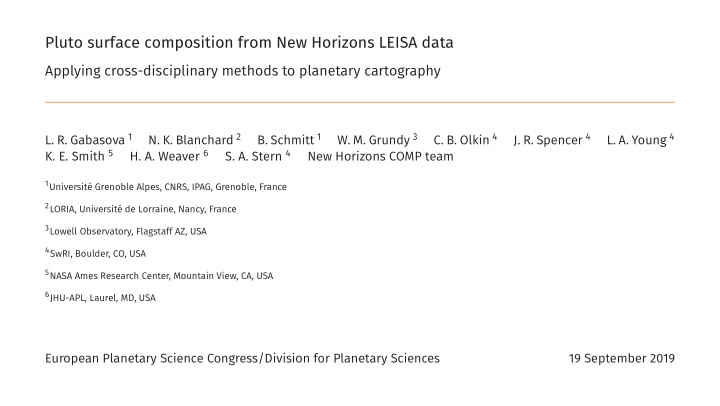



Pluto surface composition from New Horizons LEISA data New Horizons COMP team European Planetary Science Congress/Division for Planetary Sciences 6 JHU-APL, Laurel, MD, USA 5 NASA Ames Research Center, Mountain View, CA, USA 4 SwRI, Boulder, CO, USA 3 Lowell Observatory, Flagstaff AZ, USA 2 LORIA, Université de Lorraine, Nancy, France 1 Université Grenoble Alpes, CNRS, IPAG, Grenoble, France 19 September 2019 Applying cross-disciplinary methods to planetary cartography L. R. Gabasova 1 N. K. Blanchard 2 B. Schmitt 1 W. M. Grundy 3 C. B. Olkin 4 J. R. Spencer 4 L. A. Young 4 K. E. Smith 5 H. A. Weaver 6 S. A. Stern 4
What maps do we still need to produce from the New Horizons flyby data? 0/13
Pluto datasets global • Global quantitative composition maps from LEISA and inverse modeling • Global spectral index maps from LEISA Pending work: encounter hemisphere LEISA Hapke modeling of same (Protopapa et al., 2017) (Schmitt et al., 2017) encounter hemisphere LEISA Spectral index maps for CH 4 , N 2 , CO, H 2 O, red material MVIC Products published to date: global MVIC Spectral slope (Earle et al., 2018) encounter hemisphere LORRI, MVIC DEM (Schenk et al., 2018) global LORRI, MVIC Panchromatic reflectance (Schenk et al., 2018) 1/13 980 nm CH 4 band (Earle et al., 2018)
How do we make the global LEISA maps? • LORRI and MVIC-based global maps were produced using feature-based registration • LEISA datasets have much lower resolution and fewer identifiable sharp-edged features Intensity-based registration Method often used for medical imagery; compares intensity patterns in the images to be registered with different metrics (cross-correlation, mutual information etc). Validating LEISA registration: a) high-resolution data; b) misregistered low-resolution data; c) registered low-resolution data For more detail on intensity-based registration, refer to: Gabasova et al. 2019, Pluto System After New Horizons abstract #7029, and upcoming Icarus special issue 2/13
Global spectral index and band depth maps 3/13 1.7- µ m CH 4 integrated band depth map
Global spectral index and band depth maps 4/13 2.15- µ m N 2 integrated band depth map
Global spectral index and band depth maps 5/13 H 2 O spectral index map (from wavelength bands centred around 1.39 and 2.06 µ m)
Global spectral index and band depth maps 6/13 Red material spectral index map (from wavelength bands around 1.44 and 1.66 µ m)
7/13 Qualitative classification of N 2 :CH 4 ice terrains Terrain classes calculated with a Gaussian mixture model from 1.7 µ m CH 4 band depth vs 2.15 µ m N 2 band depth
Qualitative analysis Summary of observations from LEISA maps: • diffuse methane presence in high latitudes Correlating LEISA maps with MVIC and LORRI datasets suggests the following: • a largely continuous equatorial belt of CH 4 - and N 2 -rich bladed terrain • an equatorial belt of dark organic tholin-type material, deposited by atmospheric haze • H 2 O ice in longitudes outside Sputnik Planitia corresponding to exposed substrate Quantitative surface modeling is required to validate these interpretations. 8/13 • a global methane belt in the 0-30 ◦ N latitude range • N 2 presence in the 0-30 ◦ N belt, in Sputnik Planitia, and in medium-latitude uplands • red material presence in a near-global 0-30 ◦ S belt, interrupted by SP • strong correlation between: a) N 2 and CH 4 , b) H 2 O and red material • CH 4 -rich dissected/eroded terrain with N 2 infill in high latitudes
The problem with modeling Pluto’s surface spectra • 6 components with independent grain sizes • 4 mixing modes (areal, vertical, granular, molecular) Schematic representation of the various materials present on Pluto and their possible mixing states (adapted from Schmitt et al., 2017) • Lowest-resolution exhaustive computation time of all the spectra = 1500 years on 1000-core cluster • Simple iterative optimization e.g. gradient descent not possible: too many local minima 9/13 → approx. 45-dimensional problem
Metaheuristics for Great Good! What are metaheuristics? High-level heuristics designed to find a sufficiently good global solution to a complex problem. Simulated annealing An algorithm inspired by annealing in metallurgy, which combines gradient descent with stochastic perturbations (slowly decreasing in probability over time) to escape local minima. For details of SA algorithm adapted to radiative transfer modeling, refer to: Gabasova et al, 2018, EPSC abstract #537 (http://www.koliaza.com/files/EPSC_2018_Gabasova.pdf) Schema showing the concept behind simulated annealing (Ghasemalizadeh et al., 2016) 10/13
Recent modifications to inverse fitting model • Initial radiative transfer model (RTM) backend in 2018 was Spectrimag as developed by Douté and Schmitt (1998) • Now replaced with DISORT (originally developed by Stamnes et al., 1988, rewritten for C with efficiency improvements by Buras et al., 2011) Advantages of new backend: • Vertical stratification support • Open source code, permitting the project to be shared with all dependencies • Guarantees more accurate results; DISORT is frequently used as a reference model for RTM testing (e.g. in Wang et al., 2015) 11/13
Simple test case: Sputnik Planitia Simulated annealing/DISORT fit of LEISA ROI located in Sputnik Planitia 0.4 0.4 g 25 cm Grain size N 2 -rich ice + Pure CH 4 Composition 2 1 Layer RMSE over absorption bands: 5% 12/13 Coarse-grained CH 4 :N 2 binary ice, covered with thin layer (100 µ m) of pure CH 4 ice dilute CH 4 (0.7%) 100 µ m
Objectives for further development Compromise between accuracy, correctness and efficiency; given indefinite time, the model will converge accurately, but practical constraints apply. 1. How close must the initial spectrum be to allow the model to converge in a reasonable time? 2. On which part of the spectrum is accuracy most critical? 3. How badly does the error grow with inaccuracies? If error grows slowly enough, focus on efficiency with different strategies: • Seed the annealing with computed solutions for nearby points • Create a dictionary of seeding points Validate at each step by using maps of fake spectra of progressively reduced accuracy 13/13
Recommend
More recommend